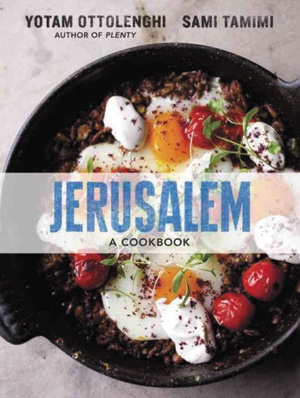Cookbooks offer flavors of the Mideast
Published June 26, 2013
I’ve looked through, and cooked from, hundreds of cookbooks. My criteria for a good cookbook is one that features mouth-watering photography, or has interesting historical or background text, or combines foods with unusual flavors, or includes recipes that are easy to follow. And then there’s the ultimate test of a great cookbook: recipes that actually work.
“Jerusalem: A Cookbook” (Ten Speed Press, $35) is that rare cookbook that satisfies all of my criteria. Its authors are Yotam Ottolenghi, the acclaimed London chef and restaurateur, and Sami Tamimi, his partner and head chef of the restaurant Ottolenghi. These co-authors, both born in Jerusalem, bring a special dimension to their cookbook: Ottolenghi is an Israeli who grew up in West Jerusalem, and Tamimi is a Palestinian who grew up in East Jerusalem.
“Jerusalem” is a gastronomic journey that celebrates Israel’s cultural diversity. The splendor of this culinary melting pot, which features traditions of Ashkenazi and Sephardic Jews, Arabs and Christians, is exquisitely photographed, vividly described, and enticingly represented in a wonderful collection of intriguing recipes.
From the chapter titled “Stuffed,” you’ll find unique versions of classic Palestinian, Lebanese and Jewish dishes, including Jewish variations from Syria, Turkey and Libya. Among my favorites are eggplants stuffed with a cinnamon-lamb mixture and potatoes stuffed with an herby ground beef and potato filling and topped with a piquant tomato sauce.
On the topic of hummus, that iconic Middle Eastern spread, the authors wisely refrain from assigning its origin to any one ethnic group. Rather, they recognize “hummus wars” and include recipes for “Basic Hummus,” “Hummus Kawarma with Lemon Sauce,” and “Musabaha (Warm Chickpeas with Hummus & Toasted Pita).”
There are plenty of innovative recipes for turning meats, fish, grains and vegetables into memorable soups, salads and main dishes. Two great examples are a simple but delicious preparation of Swiss chard with a silky yogurt and tahini sauce, and a scrumptious saffron and fennel chicken salad.
The fabulous selection of pastry recipes, both savory and sweet, will most certainly lure you into the kitchen. Bagel-shaped biscuits called “Ka’ach Bilmalch,” are paired with a garlicky yogurt based dipping sauce. The combination would be great with a cocktail, a glass of wine or beer, or on its own as a mid-day nosh. On the sweet side, I loved the recipe for the Israeli version of babka called “Chocolate Krantz Cakes.” The twisted yeast cake, layered with rich chocolate and glistening from a liberal coating of sugar syrup, tasted just like the one I had from a bakery in Tel Aviv.
All of the recipes in “Jerusalem” incorporate traditional Middle Eastern spices, such as sumac, allspice, cinnamon, coriander, cumin, fennel and thyme. Those lovely aromas will perfume your kitchen. If the recipe calls for a spice blend, you can create one at home from the simple recipes listed in the chapter, “Condiments.”
With Jonathon Lovekin’s stunning photography, the experience of cooking from Jerusalem will have you imagining the sounds and sights of Jerusalem’s crowded streets and busy markets. With the intoxicating aromas wafting through your kitchen, and the exciting flavors invigorating your palette, “Jerusalem” is a cookbook you will treasure.
Another wonderful addition to the Middle Eastern cookbook shelf comes from food writer and two-time cookbook author Louisa Shafia. In “The New Persian Kitchen” (Ten Speed Press, $24.99) Shafia explores the culinary traditions of Persia and highlights the contributions to that cuisine made by Jews, Muslims, and Zoroastrians.
As with other Middle Eastern cuisines, this book feature dishes whose unique flavors come from a masterful combination of spices (such as sumac, saffron, and turmeric), fruits (such as dates, limes, pomegranates, and tamarind), and lots of fresh herbs. Take, for example, the “Persian Gulf-Style Spicy Tamarind Fish Stew.” The essence of this quick-to-make dish comes from a marriage of turmeric, tamarind concentrate, Serrano chiles, and fresh cilantro. And just like most recipes in this book, anyone can make it.
All of Shafia’s recipes are short and have relatively few steps. For a lamb kebab dish, you marinate the lamb overnight in a paste of ground walnuts, pomegranate molasses, garlic, olive oil and parsley. The next day, you simply thread the meat on a skewer and grill it. Presto, delicious Persian cuisine.
If you are looking for a new spin on some of your traditional Jewish holiday fare, Shafia, whose mother is Jewish, includes great recipes for a date-packed charoset, Persian “matzo” balls, and koloocheh, a tasty date and walnut-filled cookie made by Persian Jews on Purim.
And to keep you cool on a sweltering St. Louis summer day, there is a terrific chapter on “Beverages.” The recipes will transform your cravings for limes, coffee, sour cherries, or dates, into ultimate gourmet thirst-quenchers.
Whether your goal is to experiment with unique flavors, to try out some easy to follow but exotic recipes, or to learn more about Persian cuisine, The New Persian Kitchen is the cookbook for you.
Margi Lenga Kahn is the mother of five and grandmother of four. A cooking instructor at the Kitchen Conservatory, she is currently working on a project to preserve the stories and recipes of heritage cooks. She welcomes your comments and suggestions at [email protected].















